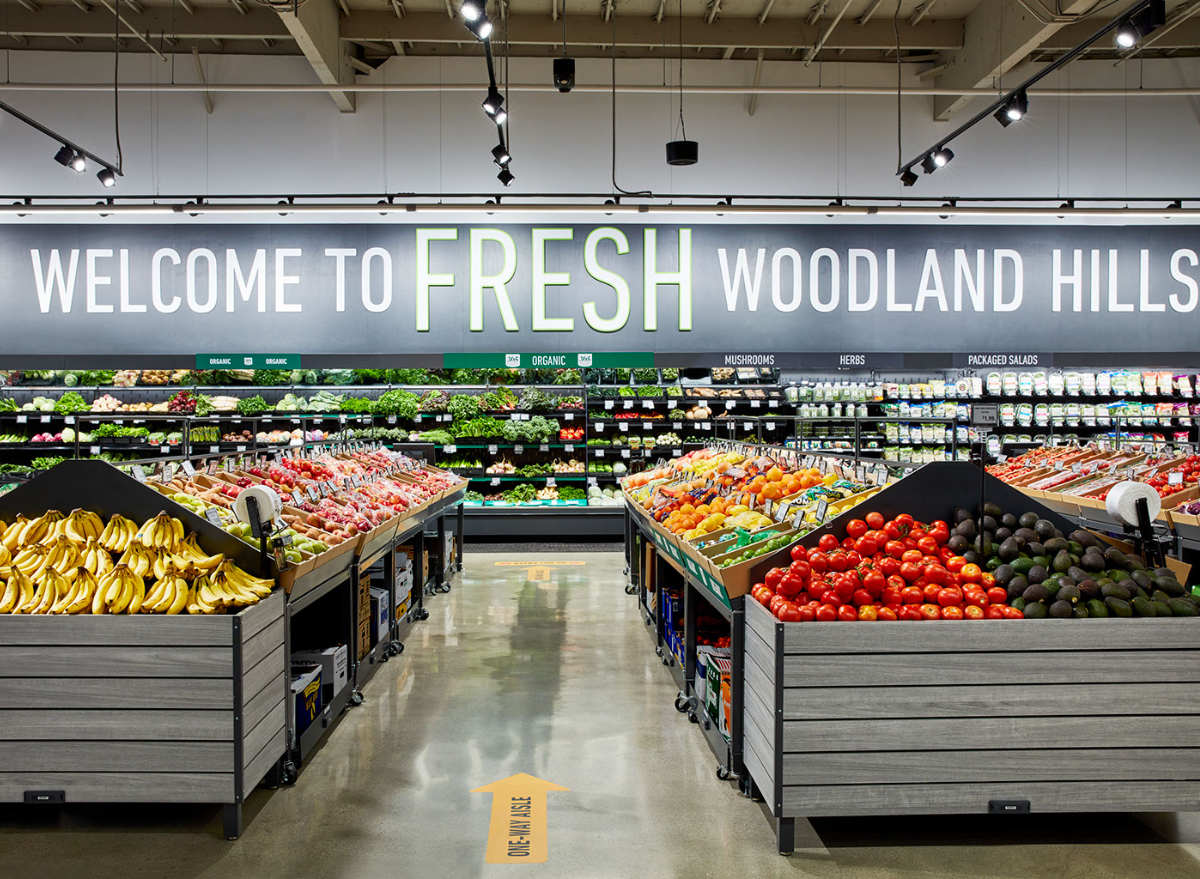Amazon Is Trying to Become Your Favorite Grocery Store with These Major Changes
The largest e-commerce company in the United States is setting its sights on conquering a lucrative brick and mortar market: the $800 billion grocery business dominated by Walmart. To that end, Amazon is rapidly building out its own grocery “brands”: Amazon Fresh and Amazon Go. “Fresh” stores are full-sized groceries; “Go” is a chain of convenience stores (or “c-stores”).
Today, five years after its $13 billion purchase of upscale Whole Foods, Amazon is pressing ahead in its mission to not only become a leading grocery chain—with stores that customers can walk into—but one that knows how to cater to its customers.
One way that’s sure to please those in a hurry: technological convenience through “cashierless” options, smart shopping carts, and other tech innovations for speedy checkout. Another is ensuring that the shelves are stocked with what neighborhood shoppers want.
“We give ourselves the ability to innovate, test and learn, and adapt to meet the changing needs of our customers,” Jeff Helbling, VP of Amazon Fresh, recently said in an interview with Progressive Grocer.
And that includes special or regional appetites. “For example,” added Helbling, “at our Amazon Fresh store in Seattle, we kept hearing from customers that they wanted collard greens in our prepared foods hot bar, so we added them to our menu.”
Here is a rundown of what’s in store—literally—for shoppers as Amazon re-imagines the in-person, full-service grocery experience.
What’s Out (and Then In)
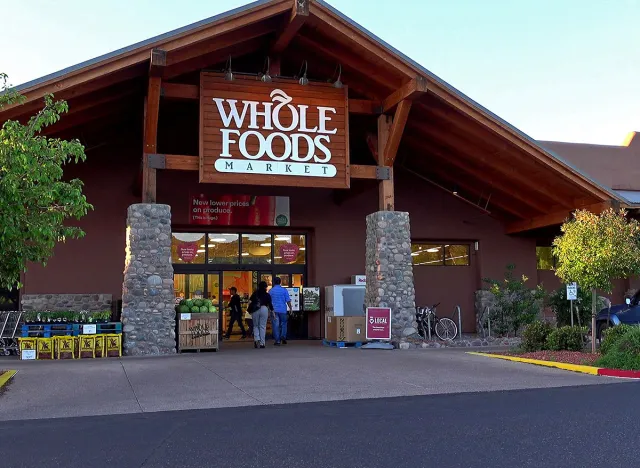
Amazon is on a planned spending spree as it pushes to add its Amazon Fresh and Amazon Go shopping brands to the top of the national grocery-chain list, but it’s also shutting down what apparently isn’t working—six of the company’s 511 Whole Food markets.
As of May 6, Whole Foods in Montgomery and Mobile, Ala.; the DePaul section of Chicago; Tarzana, Calif.; and Brookline, Mass., were shuttered. Another store is closing later in May in Chicago’s Englewood neighborhood.
According to an email by a company spokeswoman quoted by Bloomberg, “As we continue to position Whole Foods Market for long-term success, we regularly evaluate the performance and growth potential of each of our stores, and we have made the difficult decision to close six stores.”
Apparently, the performance is expected to be better at these six new Whole Food markets opened since January: two in San Francisco; Washington D.C.’s Glover Park neighborhood; Towson, Md., Sherman Oaks, Calif., and in the One Chicago high-rise in the Windy City.
House cleaning at Amazon also meant closure for its 33 “4-Star” stores, which featured popular products on the company’s website. It also shut down 24 bookstores and nine mall-located pop-up kiosks that sold Amazon products such as Kindles and Echos.
For more, see This Retail Chain is Closing Stores to Focus on Supermarkets.
Amazon Is Getting Fresh
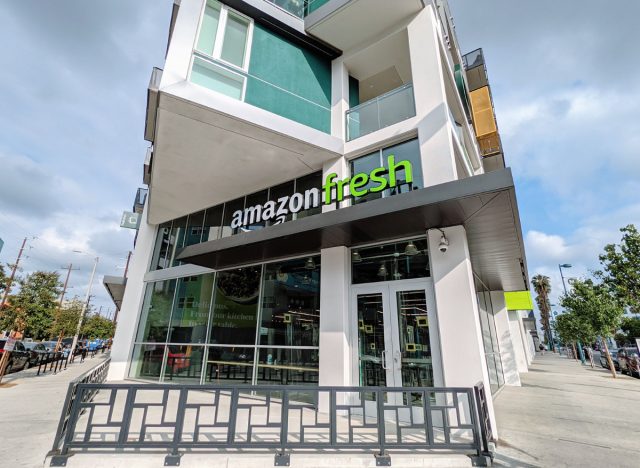
Formerly known as Amazon Go Grocery and once delivery-only, Amazon Fresh is the star of Amazon’s emerging brick-and-mortar grocery portfolio. Not only will it offer quality groceries without the Whole Foods price tag, but the stores are also as futuristic as it comes—think cashierless shopping with “smart” carts and Alexa stations on hand to answer questions. (Plus, see slide no. 4: At Amazon, You Can ‘Just Walk Out’.)
The first Fresh store opened in the summer of 2020 in Woodland Hills, Calif. Now numbering 30, with the last one opening May 5 in Murrieta, Calif., the stores are located in six states, with more to come: California (now 13 stores), Illinois (seven), Washington (four), Virginia (two), Maryland (one) and Pennsylvania (one) — and Washington, D.C. (one). According to Progressive Grocer, they range in size from 25,000 to 45,000 square feet.
(Proving that a new grocery store is hot news, the rumor out of the Minneapolis–St. Paul Business Journal is that the plans for a new building going up at a local shopping center have a design element—green awnings—similar to Amazon Fresh stores.)
Amazon Fresh has the modern look of a Whole Foods, but it is designed to be mainstream in its offerings and has been compared to Trader Joe’s in product range. The difference is that Amazon Fresh will sell family-favorite, brand-name staples like Kraft Mac & Cheese.
Prices at the Fresh stores will be lower than Whole Foods, according to CNN Business, and they will carry Amazon-exclusive, less costly brands like 365 and the company’s two new offerings, Amazon Fresh Plant-Based and APlenty food brands.
Fresh Plant-based offers 15 protein-rich products, including nuts, “chicken” and “beef” patties, and meatballs. APlenty will include 100s of items as it’s ramped up; all products are made without artificial flavors, synthetic colors, or high-fructose corn syrup.
Amazon also plans to move into the European market, with 260 Fresh stores slated for the UK by 2024. Sixty will be opened this year. Amazon is also looking at opportunities in Spain, Italy, and Germany.
Amazon Is Ready to ‘Go’
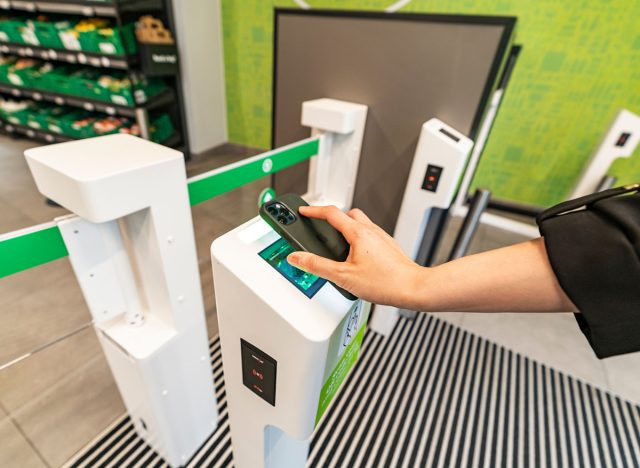
In addition to building itself as a grocery store chain, Amazon is keeping an eye on satisfying quick-trip suburban shoppers with the Amazon Go family of convenience stores. The first opened in 2018 in Seattle; today there are 24 stores nationwide, the latest in Mill Creek, Wash., north of Seattle.
From Mill Creek the Go “c-stores” will start opening across metropolitan Los Angeles. Two have opened since the start of this year in Los Angeles. The offerings at Amazon Go include what most convenience stores stock, including local beer and wine.
What will set them apart from the c-store pack is Amazon One, a fast, safe, and efficient way to shop and pay—no wallet required. Launched in 2020, Amazon One is a recognition device that reads a person’s “unique palm signature,” according to Amazon. Fast, easy, using biometric technology that the company assures is “highly secure,” Amazon One is billed as an “enter, identify, and pay” service.
It’s optional—cash and cards haven’t disappeared with the advent of new payment technology—and requires advance signup at the device itself in Amazon Go stores. Find a store here.
At Amazon, You Can ‘Just Walk Out’
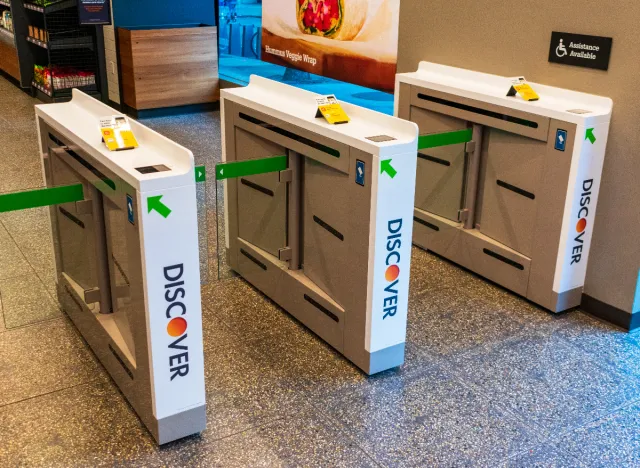
Imagine walking into a neighborhood Amazon Fresh store, grabbing a cart, and sailing out when the shopping is done—all without waiting in a checkout line.
Amazon’s Just Walk Out technology makes it possible by combining “computer vision, sensor fusion, and deep learning”—high-tech machine-learning terms that mean convenience for shoppers.
It begins with the “green” gate that greets customers at the entrance and prompts them for their preference: using Just Walk Out or the traditional way with checkout lanes.
The Just Walk Out service is easy enough to join. As Amazon explains, customers can scan the QR code in their Amazon app, scan their palm using Amazon One (see slide no. 3 above), or use the debit or credit card on their Amazon account. Any of the options will open the Just Walk Out gates.
Everything a shopper takes off the shelf is automatically added to the final tally; the technology also knows when a shopper puts an item back on the shelf and adjusts the final tab. Receipts are sent digitally.
Amazon’s ‘Smart’ Dash Carts
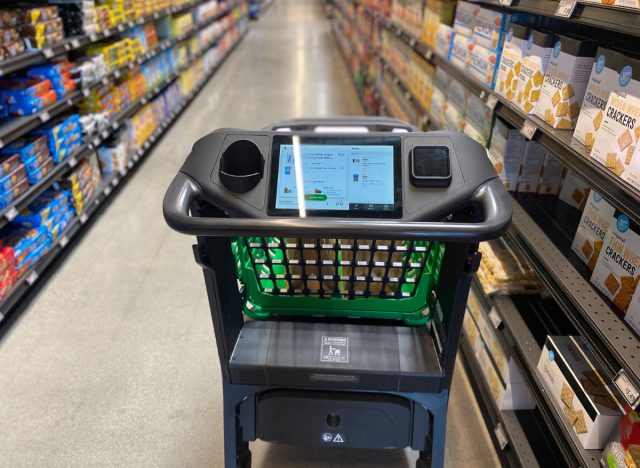
Biometric palm recognition, in-and-out without stopping for checkout, and up next in Amazon’s tech lineup—the smart shopping cart.
Called the Amazon Dash Cart, it too calls on “computer vision algorithms and sensor fusion” to identify what you’re adding to the cart. If the cart beeps when the item is dropped into the cart, all is well. If an orange light comes on, the process needs to be repeated.
When your shopping is done, just scoot through the Dash Cart lane and sensors will automatically charge your purchases to the card on your Amazon account.
Last but not least, the Dash Cart can assure that you’ll leave the store with everything you came in for: Alexa is along for the ride. A monitor on the cart can connect to your Alexa Shopping List app. Still in the rollout phase, the Dash Cart is designed for moderate shopping—one or two bags full.
Amazon isn’t the only chain making these moves. This Regional Grocery Chain Is Spending $150 Million on Expansion.
